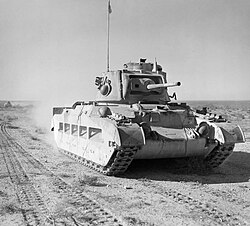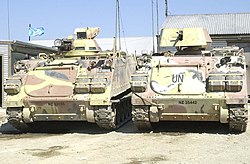Infantry equipment
Uniforms
Camouflage patterns
| Name | Origin | Image | Introduced | Withdrawn | Notes |
|---|---|---|---|---|---|
| ERDL |  | 1968 | 1980 | ||
| Tigerstripe |  | ||||
| DPM |  | 1980 | 1997 | ||
| NZDPM |  | 1997 | 2013 | ||
| NZDDPM |  | 2003 | 2013 | ||
| MultiCam |  | ||||
| NZMCU | 2013 | 2019 |
| New Zealand Army New Zealand Defence Force |
|---|
| Components |
| Administration |
| Regiments |
| Corps |
| Equipment |
| New Zealand portal |
This article lists equipment, weapons and vehicles formerly used by the New Zealand Army.
| Name | Origin | Image | Introduced | Withdrawn | Notes |
|---|---|---|---|---|---|
| ERDL |  | 1968 | 1980 | ||
| Tigerstripe |  | ||||
| DPM |  | 1980 | 1997 | ||
| NZDPM |  | 1997 | 2013 | ||
| NZDDPM |  | 2003 | 2013 | ||
| MultiCam |  | ||||
| NZMCU | 2013 | 2019 |
| Name | Origin | Image | Model | Calibre | Introduced | Withdrawn | Notes |
|---|---|---|---|---|---|---|---|
| M1928 Thompson |  | M1928A1 | .45 Automatic Colt Pistol | 1940 | [12] | ||
 | M1 | 1943 | [12] | ||||
| M1A1 | [12] | ||||||
| Sten |  | Mk II | 9×19mm Parabellum | 1941 | [12] | ||
| Mk III | 1943 | [12] | |||||
| Owen |  | 9×19mm Parabellum | [12] | ||||
| M3 submachine gun |  | M3 | .45 Automatic Colt Pistol | 1944 | 1953 | [12] | |
| M3A1 | |||||||
| Lanchester |  | Mk I* | 9×19mm Parabellum | 1949 | 1972 | [12] | |
| L2A3 Sterling |  | L2A3 | 9×19mm Parabellum | 1959 | 1989 | [12] | |
| L34A1 | 1989 | [12] |
| Name | Origin | Image | Model | Introduced | Withdrawn | Notes |
|---|---|---|---|---|---|---|
| Ordnance QF 18-pounder |  | [15] | ||||
| Ordnance QF 4.5-inch howitzer |  | [16] | ||||
| Ordnance BL 6 inch 26cwt howitzer |  | c. 1920s | 1953 | [17] | ||
| Ordnance, QF 3.7-inch mountain howitzer |  | Mk I | 1922 | 1952 | [18] | |
| Ordnance QF 25-pounder |  | 1940 | Withdrawn in 1977, still in ceremonial use | [19] | ||
| Ordnance QF 6-pounder |  | 1942 | c. 1960s | [20] | ||
| Ordnance BL 5.5-inch medium gun |  | c. 1980s | [21] | |||
| OTO Melara Mod 56 | |  | L5 | 1963 | c. 1980s | 24 purchased in 1963. [22] |
| Mistral | |  | 1997 | 2012 | 12 launchers and 24 missiles purchased in 1997. Never fully brought into service. [23] |
| Name | Origin | Image | Model | Introduced | Withdrawn | Notes |
|---|---|---|---|---|---|---|
| A7V |  | 1918 | 1919 | Single German tank captured by the New Zealand Division | ||
| Bob Semple tank |  | 1940 | 1942 | three improvised vehicles built on tractor chassis [24] [25] [26] [27] | ||
| Schofield tank | 1940 | 1943 | Wheel-cum-track vehicle. Did not enter production or service. [24] | |||
| Tank Light Mk VI, Vickers |  | Mk II Mk III Mk VI B | 1940 | 1941 | [24] | |
| Tank Infantry Mark II, Matilda |  | Mk IV CS A 12 | 1941 | 1944 | [24] | |
| Tank Infantry Mk III, Valentine |  | Mk II Mk III Mk V | 1941 | 1960 | [24] | |
| Tank, Cruiser, Mk V, Covenanter | Bridgelayer | 1942 | c. 1950s | [28] | ||
| M3 Stuart |  | M3 M3A1 M3A3 | 1941 | 1970 | [24] | |
| M4 Sherman |  | IB, IC, III, VC | 1943 | 1945 | [24] [29] | |
| Sherman Firefly |  | 1944 | 1945 | Conversion of US supplied Sherman tanks with British 17 pdr gun. [24] | ||
| M10 Tank Destroyer |  | 1944 | 1945 | [30] | ||
| Centurion |  | Mk III Mk V | 1953 | 1968 | [24] | |
| M41 Walker Bulldog |  | M41A1 | 1960 | 1982 | [24] |
| Name | Origin | Image | Model | Introduced | Withdrawn | Notes |
|---|---|---|---|---|---|---|
| Car Light Reconnaissance, Canadian GM (R.A.C.), Otter |  | Mk II | 1941 | 1944 | [24] | |
| M3 White Scout Car |  | M3A1 | 1941 | 1945 | [24] | |
| Daimer Dingo |  | Mk II | 1942 | 1962 | [24] | |
| Daimler Ferret |  | Mk I Mk II | 1956 | 1982 | [24] [31] | |
| FV101 Scorpion |  | 1982 | 1998 | Armoured reconnaissance vehicle/fire support variant of CVR(T) family [24] [32] [31] |
| Name | Origin | Image | Model | Introduced | Withdrawn | Notes |
|---|---|---|---|---|---|---|
| Universal Carrier |  | No. 1 No. 2 No. 3 | 1939 | 1958 | [24] | |
| Armoured Car, Marmon-Herrington |  | Mk II Mk III | 1941 | 1941 | [24] | |
| Armoured Car, Humber |  | Mk II Mk III | 1941 | 1942 | [24] | |
| Car Armoured Light Standard, Beaverette |  | Beaverette NZLP | 1942 | 1945 | [24] | |
| Staghound armoured car |  | 1943 | 1944 | Used in Italian Campaign [24] | ||
| Armoured Carrier, Wheeled, New Zealand Pattern | 1943 | 1957 | [24] | |||
| Armoured Car, Daimler |  | Mk II | 1953 | 1960 | [24] | |
| M113 Armored Personnel Carrier |  | M113A1 | 1970 | 2005 | [24] [33] [34] [32] [31] |
| Name | Origin | Image | Model | Introduced | Withdrawn | Notes |
|---|---|---|---|---|---|---|
| Land Rover Series I |  | Series I 80" | 1951 | |||
| Bedford RL | 1958 | 1989 | Built under licence in New Zealand. | |||
| Land Rover Series II | Series II 109" | 1959 | ||||
| Series IIA 88" | 1965 | |||||
| Series IIA 109" | 1965 | |||||
| Land Rover 101 Forward Control | Series IIB 110" WB Forward Control | 1967 | ||||
| Land Rover Series III Stage One | Series III 109" V8 | 1982 | ||||
| High Mobility Multipurpose Wheeled Vehicle |  | Borrowed U.S. vehicles in Afghanistan were used by the New Zealand Special Air Service. [35] |
{{cite book}}: |work= ignored (help)